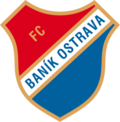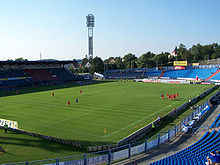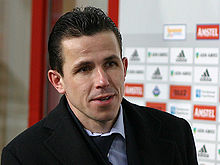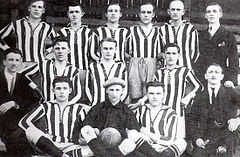- FC Baník Ostrava
-
Baník Ostrava 
Full name FC Baník Ostrava Nickname(s) Baníček Founded 1922, as SK Slezská Ostrava Ground Bazaly, Ostrava
(Capacity: 17,372)Owner Tomáš Petera Manager Pavel Malura League Gambrinus liga 2010-11 Gambrinus liga, 14th Home coloursAway coloursFC Baník Ostrava is a football club from the Silesian part of the city of Ostrava, Czech Republic. It is based in Slezská Ostrava district of the city.
Founded in 1922 as SK Slezská Ostrava, Baník is one of the most traditional clubs in the country - it has won numerous national and international trophies. Their home stadium is Bazaly, and club colours are blue and white. Baník's greatest rivals are Sparta Prague; with a regional "Silesian derby" taking place with SFC Opava. In 2005 however SFC Opava was relegated from the Gambrinus liga. Currently, there is a friendship between the supporters of Baník and GKS Katowice from the Silesian region of Poland.
Contents
History
Formation and history to 1937
The club was founded on 8 September 1922 as SK Slezská Ostrava, when 20 activists signed the establishment treaty in the U Dubu restaurant. The signatories were mostly poor coal miners from the Kamenec coal mining settlement in Ostrava. The organizers of the founding were Karel Aniol, Arnošt Haberkiewicz, Petr Křižák, František Mruzek and Jaroslav Horák.[1] The club was officially registered on 14 October 1922. Karel Aniol became the club's first president. First jerseys of SK Slezská Ostrava were red-white striped. Since April 1923, however the club played with white jerseys and blue shorts. These colours were used since then. The first match ever occurred on 4 March 1923, when SK Slezská Ostrava faced reserve team of famous local side Slovan Ostrava.
SK Slezská Ostrava was a poor club, raising money for functioning of the club was a common concern. It had no own playing field and was forced to loan fields from wealthier clubs. The first own field was built in autumn of 1925 at Kamenec. It was however stony and did not meet requirements of the football officials. In 1934 club activists succeeded in renting the land at Stará střelnice from regional wealthy industrialist Count Wilczek. During the summer of 1934 a new field was built there. Many workers volunteered to help with the construction for free. Workers and coal miners often came directly from shifts to build the field.[2]
SK Slezská Ostrava began to compete with other teams in the league system in spring of 1923. It started in the lowest division (III. třída župy) and was promoted to higher division the same year. It took however some time for the club the appear in the highest divisions of football in Czechoslovakia. In 1934 the club won the promotion to the Moravian-Silesian Division, one of the highest leagues in the country. The promotion made SK Slezská Ostrava a popular team in the city and the public interest was rising. The 1935 derby against Slovan Ostrava was watched at Stará střelnice by 5,400 spectators.[3]
Since 1934 the club began also to pay money to footballers, which was made legal by the Czechoslovak Football Association the same year. In the Moravian-Silesian Division, the club played in the safe mid-table position, and faced regional sides like SK Baťa Zlín or Polonia Karwina. In the 1936-1937 season, SK Slezská Ostrava won the Moravian-Silesian Division and advanced to the qualification tournament for the First League. The team faced several noted sides, including the DFC Prague and Čechie Karlín, and finally won the tournament to be promoted to the First League for the first time in history.
From 1937 to 1952
The First League in Czechoslovakia was dominated by Prague teams at that time, which were advanced in all aspects. Promotion to the First League was therefore a big success for SK Slezská Ostrava. In 15 years the team advanced from the obscure minnows to the highest level of football in the country. The first league match at Stará střelnice was played on 22 August 1937 against 1. ČsŠK Bratislava. In the second match, the newcomer team faced famous Sparta Prague in Prague. Though Sparta's roster was full of national team players, Baník won 3-2 and caused immediate sensation.[4] SK Slezská Ostrava survived three seasons in the First League before being relegated back to Division in 1940.
SK Slezská Ostrava played in the Division until 1943, when it was again promoted to the First League. Promotion to the highest league sparked even stronger interest in football of local people. Later famed opera singer Rudolf Asmus even sang the new anthem for the club. In the 1943-1944 season the home attendances of SK Slezská Ostrava reached the highest level so far. The match against Slavia Prague was attended by 33,000 people.[5] The club was relegated back to the second-tier division (now named Second League) in 1949, but won the league in 1950 and returned to the First League. The club changed its name after World War II and again in 1948 after the communist coup d'état.
From 1952 to 1967
In 1952 the club adopted the name DSO Baník Ostrava. Since then the name went only through slight changes. In the 1954 season, Baník achieved its biggest league success so far, ending second in the league after Sparta. In 1959 Baník played for the last time at the old Stará střelnice stadium. Stará střelnice did not meet requirements made by the football association. The pitch was not grassy, but covered with slag, which was also a reason to close down the stadium. New Bazaly stadium was constructed in 1959 in Slezská Ostrava, and was opened on 19 April 1959.
In the 1965-1966 season Baník was weakened by the generation change. It ended 13th in the league table and was relegated to the Second League. A year later Baník was again promoted to the top division. Since then Baník plays exclusively in the top flight of football in the country.[6]
The Golden Era
In the 1972-1973 season Baník won the Czechoslovak Cup. It was club's first domestic trophy. As a winner of domestic cup, Baník advanced to the Cup Winners' Cup. It was a first European cup appearance in club's history. Baník eliminated Irish Cork Hibernians F.C. in the first round, but was eliminated in second round by East German 1. FC Magdeburg, who later won the cup. In the 1974-1975 season of the UEFA Cup Baník eliminated Real Sociedad, FC Nantes and S.S.C. Napoli, only to be eliminated in the quarter-finals by eventual Cup winners Borussia Mönchengladbach.
In the 1974-1975 season Baník finished 13th in the First League. No one expected the team to make a good result in the forthcoming season. Jiří Rubáš was appointed as a new manager of Baník in the half of the 1975-1976 season. Baník managed to improve in the second half of the season and became Czechoslovak champions for the first time in history. Before the last match at Škoda Plzeň, Baník was second in the league table, trailing one point after Slavia Prague. Baník however won 1-0 in Plzeň, while Slavia lost 0-1 to Slovan Bratislava in Bratislava. These results granted Baník the first title.
The true Golden Era in history of the club however started when Evžen Hadamczik took over as manager of Baník on 1 January 1978. Hadamczik was a young coach, without previous league experience. In 1978, the club won the Czechoslovak Cup for the second time in history. In the 1978-1979 season Baník finished second, with only worse score than champions Dukla Prague. In this season Hadamczik started also team's home stadium invincibility. On 20 August 1978 Baník lost at Bazaly to Dukla Prague. Since then Baník did not lose 74 home matches in a row, thus being almost five years undefeated at their home ground.[7] In the same season of the Cup Winners' Cup, Baník made it to the semi-finals knocking out Sporting Lisbon, Shamrock Rovers and 1. FC Magdeburg on their way. Baník was eliminated in the semi-finals by Fortuna Düsseldorf.
Team squad was stable in the Golden Era years. The best players like Lička and Vojáček were regularly playing for the national team. Others like Radimec, Rygel, Němec and Šreiner played also for the Olympic team. In the 1979-1980 season Baník won its second Czechoslovak title, finishing five points ahead of Zbrojovka Brno. In the 1980-1981 season of the UEFA European Cup Baník reached the quarter-finals, where it was knocked out by Bayern Munich. In the same season, Baník also won the First League again. In the subsequent two seasons, Baník finished second in the league table. After the 1982-1983 season, coach Hadamczik resigned, thus symbolically ending the Golden Era of the club.
From 1983 to 1991
In the following years Baník withdrew from the highest league positions. The team was undergoing another generation change and young players did not maintain their performance for the whole season. Baník however regularly appeared in the upper part of the league table. In the 1988-1989 and 1989-1990 seasons it finished second in the league. In 1991, Baník won the Czechoslovak Cup by beating Spartak Trnava 6:1 in the final match.[8] It was the last success of the club for long years to come.
Recent years
Since 1991 the club constantly underachieved. Financial problems soon joined as major sponsors were undergoing restructuralization following the collapse of communism in the country. In the 1990s, Baník achieved various results. The best was third place in the 1993-1994 season. The club however struggled for the league survival in the 2000-2001 season, and finished 14th in the table, just four points short of relegation.
The greatest success of the club in long years came in the 2003-2004 season. Baník was leading the table for most of the time and won the league for the first time in history of the independent Czech Republic. Marek Heinz became league's top goalscorer with 19 goals. In the same season, Baník finished as the runner-up in the Czech Football Cup. After the victorious season, the squad underwent dramatic change. Manager František Komňacký left and most of the crucial players were sold, including Bolf, Heinz, Laštůvka and Matušovič. This affected team performance in the next season. Baník finished on mediocre seventh place, but managed to win the domestic cup for the first time since the dissolution of Czechoslovakia.
Since then, Baník appears regularly in the upper part of the league table, and finished twice on the third place.
Historical names
 Bazaly, stadium of FC Baník Ostrava
Bazaly, stadium of FC Baník Ostrava
- 1922 — SK Slezská Ostrava (Sportovní klub Slezská Ostrava)
- 1945 — SK Ostrava (Sportovní klub Ostrava)
- 1948 — Sokol Trojice Ostrava
- 1951 — Sokol OKD Ostrava (Sokol Ostravsko-karvinské doly Ostrava)
- 1952 — DSO Baník Ostrava (Dobrovolná sportovní organizace Baník Ostrava)
- 1961 — TJ Baník Ostrava (Tělovýchovná jednota Baník Ostrava)
- 1970 — TJ Baník Ostrava OKD (Tělovýchovná jednota Baník Ostrava Ostravsko-karvinské doly)
- 1990 — FC Baník Ostrava (Football Club Baník Ostrava, a.s.)
- 1994 — FC Baník Ostrava Tango (Football Club Baník Ostrava Tango, a.s.)
- 1995 — FC Baník Ostrava (Football Club Baník Ostrava, a.s.)
Achievements
International
- Mitropa Cup Winner: 1989
- Intertoto Cup Winner: 1970, 1974, 1976, 1979, 1985, 1988, 1989
- European Cup quarterfinal: 1981
- Cup Winners' Cup semifinal: 1979
- UEFA Cup quarterfinal: 1975
Domestic
- Czechoslovak Champion (3 times): 1976, 1980, 1981
- Czechoslovak First League Runner-up (6 times): 1954, 1979, 1982, 1983, 1989, 1990
- Czech Champion (once): 2004
- Czechoslovak Cup Winner (3 times): 1973, 1978, 1991
- Czechoslovak Cup Runner-up (once): 1979
- Czech FA Cup Winner (once): 2005
- Czech FA Cup Runner-up (twice): 2004, 2006
- Biggest win 10-1 versus Hradec Králové in the 1956 season
- Biggest loss 0-9 versus Dukla Prague also during 1956 season
Standing within the Czech Republic and beyond
 Club supporters during the home match against 1. FC Brno
Club supporters during the home match against 1. FC Brno
Banik are known throughout the Czech Republic as having one of, if not the, most loyal and vociferous groups of supporters in the country. The Bazaly is one of the more highly attended stadiums within the Gambrinus liga[9][10][11] where a club song "Baníčku, my jsme s tebou!" (literally 'Banik, we are with you!') and a sea of flares is not unusual. Fans pride themselves on their displays of devotion to Baník, which include numerous banners and demonstrations of both their love for the club and detest of the opposition.
Ultras supporters of Baník call themselves Chachaři, which means "bad boys" in regional dialect.[12] Some of the ultras' songs contain lyrics proudly demonstrating willingness to not only sing, but also fight for their club. Baník's ultras have made friendships over the years, and in 2006 celebrated 10 years of partnership with 2nd division Poland club, GKS Katowice. The celebration took the form of a game between the two teams, organised by the clubs directors. The fixture took place at GKS' stadium, where throughout the 90 minutes the opposing sets of fans sung one another's songs. At the end of the game, both sets of fans climbed over metal fences in order to race onto the pitch come the final whistle to embrace and exchange scarves.[13] Another club to have had links with Baník is Slovak football club FC Spartak Trnava. Banik's supporters are well known in the Czech Republic and especially in the 1990s clashed frequently with supporters of other clubs. In Europe they clashed with Dutch, German and British police whilst following Baník during UEFA Cup ties.
Transfers
 Tomáš Galásek, who moved to the Netherlands in 1996
Tomáš Galásek, who moved to the Netherlands in 1996
Baník have produced numerous players who have gone on to represent the Czech national football team. Over the last 15 years there has been a steady increase of young players leaving Baník after a few years of first team football and moving on to play football in leagues of a higher standard, with the Belgian First Division, Italy's Serie A and also the German Bundesliga being popular destinations. Young Czech footballers tend to fit into two catergories - highly skilled, technically sound attacking players, or strong, athletic and somewhat uncompromising defenders. Baník, as with all Czech clubs, are unable to demand huge sums of money for the signature of their youngsters. Top transfers include Václav Svěrkoš recent transfer to FC Sochaux for an undisclosed fee (believed to be in the region of £1.8 million) is a highlight of recent seasons. It isn't the first time Baník have allowed Svěrkoš to move on, with a previous transfer to Borussia Mönchengladbach during the 2003/2004 season for £1.2 million. This still pales in comparison to the Milan Baroš transfer of 2001/2002 season of £4.5 million.
As with all football fans, supporters of Baník are disappointed when a loved member of the team decides that it is time to move on. Especially when the player signs for a bitter rival, just as Zdeněk Pospěch and Miroslav Matušovič did in 2005. Both players were highly regarded by both the coaching staff and fans at Bazaly, but decided to move on to rivals Sparta Prague. Other players who moved from Baník to Sparta, include Tomáš Řepka and Libor Sionko.
Current squad
- As of 13 November, 2011.[14]
Note: Flags indicate national team as has been defined under FIFA eligibility rules. Players may hold more than one non-FIFA nationality.
No. Position Player 1 
GK Jakub Andrejko 2 
DF Pavel Dreksa 4 
MF Martin Lukeš (captain) 5 
DF Jozef Adámik 6 
MF Lukáš Droppa 8 
DF Marek Jankulovski 9 
MF Richard Vaněk 10 
FW Gevorg Badalyan 11 
MF Ján Greguš 12 
DF Łukasz Zejdler 13 
MF Jakub Tomanica 14 
FW Zdeněk Šenkeřík 15 
FW Antonín Fantiš 16 
GK Lukáš Krbeček (on loan from Viktoria Plzeň) 17 
MF Dalibor Vašenda 18 
MF Tomáš Marek No. Position Player 19 
DF Michal Frydrych 21 
MF Tomáš Dostál 22 
MF Zdeněk Šmejkal 23 
DF Jan Zawada 24 
DF Patrik Kaizar 25 
FW Václav Svěrkoš 26 
DF Benjamin Vomáčka 27 
FW Dominik Kraut 28 
MF Pavol Poliaček 29 
MF Milan Ferenčík 30 
GK Dawid Pietrzkiewicz 31 
DF Pavel Malcharek 32 
MF Ondřej Cverna 33 
DF Michal Velner 34 
MF Martin Limanovský Out on loan
Note: Flags indicate national team as has been defined under FIFA eligibility rules. Players may hold more than one non-FIFA nationality.
No. Position Player 26 
DF Radek Coufal (at SK Kladno) 27 
DF Zdeněk Koukal (at 1. FK Příbram) 28 
FW Miloslav Strnad (at Vlašim) 29 
MF Petr Wojnar (at SK Kladno) 
FW Tomáš Vrťo (at Vlašim) Footnotes
- ^ Bruzl and Šiřina 2004, 6.
- ^ Bruzl and Šiřina 2004, 8.
- ^ Bruzl and Šiřina 2004, 9.
- ^ Bruzl and Šiřina 2004, 11.
- ^ Bruzl and Šiřina 2004, 13.
- ^ FCB.cz: Přehled umístění v lize
- ^ Bruzl and Šiřina 2004, 35.
- ^ Czechoslovak Cup Final 1960/61 - 1992/3
- ^ Divácké statistiky 2009/2010
- ^ Divácké statistiky 2008/2009
- ^ Divácké statistiky 2007/2008
- ^ Guachare, 26 December 2006
- ^ Chachaři.cz: GKS Katowice - FC Baník Ostrava 2:1 - Ja kocham GKS
- ^ http://www.fcb.cz/tymy.php
References
- Bruzl, Igor; Petr Šiřina (2004). Baníčku, my jsme s tebou!. Praha: Ottovo nakladatelství. ISBN 80-7181-124-6.
External links
Gambrinus liga · 2011–12 Baník Ostrava · Bohemians 1905 · Dukla Prague · Dynamo České Budějovice · Jablonec · Hradec Králové · Mladá Boleslav · Příbram · Sigma Olomouc · Slavia Prague · Slovácko · Slovan Liberec · Sparta Prague · Teplice · Viktoria Plzeň · Viktoria ŽižkovCzechoslovak First League · 1993–94 · 1994–95 · 1995–96 · 1996–97 · 1997–98 · 1998–99 · 1999–2000 · 2000–01 · 2001–02 · 2002–03 · 2003–04 · 2004–05 · 2005–06 · 2006–07 · 2007–08 · 2008–09 · 2009–10 · 2010–11 · 2011–12Categories:- FC Baník Ostrava
- Football clubs in the Moravian-Silesian Region
- Czech football clubs
- Ostrava
- Association football clubs established in 1922
Wikimedia Foundation. 2010.


